Genre: Action Developer: Viacom New Media Publisher: Viacom New Media Players: 1 Released: 1995
It’s generally bad form to start a review with a blanket statement, but saying “Phantom 2040 is the best 16-bit game you never played” is probably an accurate assumption. And just why would anybody want to play this game? It’s based on a masked hero in purple pajamas from an old newspaper comic strip that nobody I know actually follows. Even fans of the comic would would shrug the game off because it takes its setting and story from an obscure and futuristic cartoon version of the Phantom from the 1990s.
To make matters worse, this game came out in 1995, when the Genesis was being left behind for the next console generation. Phantom 2040 never stood a chance. It’s a shame because my quest to find a Metroid-style title on the Sega Genesis finally ended when I discovered this virtually unknown gem. Released for Genesis and the SNES both versions are virtually identical in looks and gameplay with a few minor differences, some of which I will expand on later.
Like I said earlier, Phantom 2040 is based on an obscure animated series that takes the basic concept of the Phantom, a mysterious hero whose mantle has been passed on from father to son for several generations, and places it in a cyber-punk future where the current Phantom is forced to fight against mega corporations and other evil doers. The cartoon, and by proxy the game, have a strong environmentalist message and serve as a cautionary tale about creating a future dystopia. Basically, the cartoon was a dark and mature version of Captain Planet.
This backdrop is the setting for our adventure, and it’s honestly a pretty good one. There’s a lot of story packed into the game, so much in fact that you can turn the story to a summary mode in the options if you want to skip it. I wish more games would give me that option, though during your first playthrough you might prefer to leave the story intact. The plot is basically what I already described above. You’re working to protect the environment and prevent a corporation called Maximum from taking over the world. It’s simple but entertaining, and along the way you’ll meet an interesting cast of friends and foes. I’m not really too familiar with the source material, yet I still found the story to be enjoyable.
Graphically, this game is sharp and detailed and what you’d expect from a Genesis title that came out this late in the system’s life. It doesn’t use too many bells and whistles, but it’s definitely attractive. The art style and coloring give it a great comic book feel though some of the characters have really silly designs that you’ll either love or hate. Phantom himself is probably the biggest issue with the graphics, as he doesn’t animate that well and looks kind of dorky. Some of the enemies can be a bit generic, especially the horde of gray robots you fight most of the time. The game tries to be non-violent, so when you fight actual humans they usually just fall off the screen when defeated instead of exploding like your mechanical opponents. As an overall package, the game still looks good and the dark and broody atmosphere is actually complimented well by the limited color palette of the Genesis.
The real reason we’re here is the gameplay, and this is where Phantom 2040 truly shines. At first it’s a bit confusing because it lays a map of the city in front of you to explore. The levels themselves are large and open, allowing you to hunt out secrets and power-ups. This is where the first obvious parallel to the Metroid series is apparent. However, if you listen to where you’re told to go you shouldn’t have much trouble finding your way around.
Also like Metroid, you’ll find various power-ups such as weapons and items that will let you access areas that you may have been unable to before, meaning you can go back to levels you’ve already cleared to find things you missed the first time around. You start the game with a pistol and a grappling beam-like thing. Your pistol and all of your other special weapons use energy that you need to replenish, though you can also attack by punching and kicking in order to reserve that energy for tougher fights. Your grappling beam can temporarily stun enemies and is also used to climb and swing in Bionic Commando or Spider-Man fashion. It’s probably the single most important item you have for exploring the levels. As you progress you find items that increase the length of your health and energy bars, as well as the length of your grappling beam.
Even more non-linearity is added to the game by occasionally forcing you to make important decisions which effect what levels you play through, what items you find and ultimately which of the multiple endings you receive. There are also different routes you can take through certain levels that will alter how you make your way through the game. Even at the very start you can choose to go left to rescue a scientist or go right to fight a boss. This adds loads of replay value if you want to experience everything that Phantom 2040 has to offer.
The controls are tight but not quite perfect. Something I should mention is that the SNES version has a slight edge over the Genesis in this category. The SNES version has a button dedicated to your grappling beam and also uses one of the trigger buttons to keep you standing in place so you can fire in multiple directions without moving. Considering that Phantom 2040 was released in 1995, I have no idea why they didn’t have the option to map these functions to some of the buttons on the six-button Genesis controller, as it ends up making this version of the game slightly more difficult to play.
Another issue I have with the gameplay is they went with a password system instead of saves. In this type of game you have to spend a lot of time searching and discovering things and the password checkpoints are only at the end of each “episode,” which are few and far between. It’s annoying to find a lot of cool power-ups only to have to turn the system off and lose your progress because you don’t have time to reach the next level or even worse, you’re stuck and not sure where to go next, but if you quit you lose your progress all the way back to the last password.
As far as sound quality goes Phantom 2040 is passably impressive. I don’t think you’ll find yourself humming the music any time soon, but it’s not bad. The sound-effects are also above average, and while they won’t blow your mind you’ll appreciate the obvious effort that was put into making this title.
Phantom 2040 is the very definition of the term hidden gem. There is no doubt in my mind that if this game had been of a more popular franchise like Batman or even an original concept that was more heavily marketed, and if it had come out a few years earlier, that it would be a fondly remembered 16-bit classic. As it stands, practically nobody has even touched this game, and that’s unfortunate because not only is it the closest thing to Metroid on the Sega Genesis, it oozes with quality design and gameplay.
The minor issues that I mentioned do hold it back and are reflected in the final score, but it’s more than worth it to see past them and play this game. Because there’s zero demand for this cartridge, it can be purchased for next to nothing, so what have you got to lose? If you’re a fan of Metroid-style gameplay then give this game some time. I can almost guarantee you’ll enjoy it.
SCORE: 8 out of 10

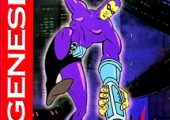
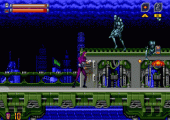
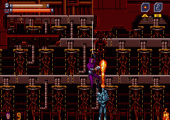
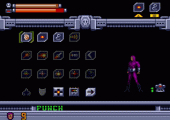
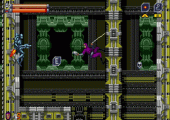
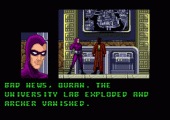
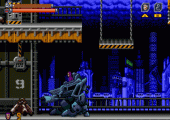
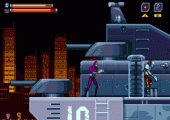
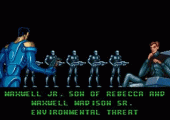
Note: On the Genesis 6-button controller, Z activates the grappling hook and Mode makes you stand in one place and shoot.